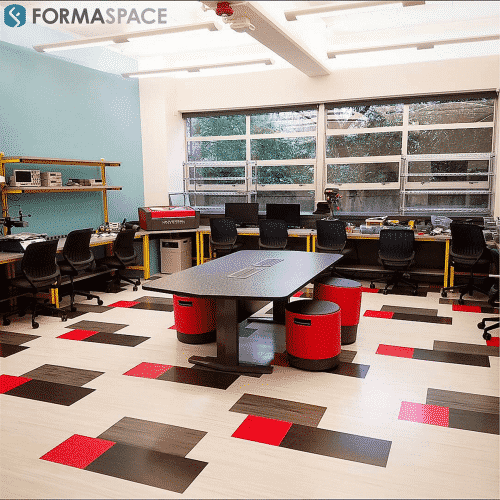Esports are generating excitement among a new generation of college and university students. We take a look at the new phenomenon of varsity esports leagues, including the availability of esports scholarship programs designed to attract exceptional computer game players.
Traditional varsity sports, such as football, basketball, and baseball, are facing a new competitor — esports — which have suddenly emerged to become one of the fastest growing sports categories at US colleges and universities.
The sports network ESPN now counts more than 127 schools participating in esports league play at the varsity level. By some estimates, esports revenues will grow to $900 million in 2019, which represents tremendous growth for a sector that barely existed ten years ago.
Indeed, esports programs are maturing rapidly and taking on many of the characteristics of traditional varsity sports, ranging from lucrative team sponsorships and advertising deals to intensive player recruiting and coaching programs, to — wait for it — full-ride esports scholarships for star players. Yes, you heard that right: an increasing number of schools are now offering partial and full-ride scholarships for the top talent in computer game play.
Yet, like many so-called “overnight success stories,” computer gaming as a competitive amateur and professional sport did not happen overnight — the movement has grown organically over the last 10 years as like-minded game enthusiasts have come together to form their own competitive college-level esports leagues.
New to Collegiate Esports? Here is a Quick Start Guide for Newbies.
The first thing to understand about collegiate esports is that the underlying computer gaming industry is enormous — it’s estimated to be a $150 billion market in 2019, with as many as 2.2 billion active participants world-wide — which would make it 5 times larger than the combined revenues of ALL the major professional sports leagues, including the NFL ($13 billion), MLB ($9.5 billion), NBA ($4.8 billion), and NHL ($3.7 billion).
However, despite these numbers, the traditional varsity sports leagues, such as the NCAA (National Collegiate Athletic Association) and the NAIA (National Association of Intercollegiate Athletics), haven’t been receptive to the idea of adding esports to their roster of traditional amateur college athletic sports (this is something they may yet come to regret!). No matter. New esports leagues, some created by college players themselves, others by game developers, have taken up the call.
These include:
- NACE, the National Association of Collegiate Esports, which now boasts 144 college and university level institutions.
- College League of Legends, a commercial league dedicated to League of Legends game play at the college and university level, sponsored by the game developer.
- NASEF, the North America Scholastic Esports Federation, a league focused on esports at the high-school level (making it a recruiting source for up-and-coming college players).
Esports are poised to become a major force on American college and university campuses, joining the pantheon of major college varsity sports, including football, basketball, and baseball.
At the college level, a few computer games dominate the esports playing field, with Overwatch (from Blizzard Entertainment) and League of Legends (often abbreviated to LoL, from Riot Games) currently among the most popular.
Other popular games played at the varsity level include Brawlhalla (Blue Mammoth Games), Call of Duty (Infinity Ward / Activision), Counterstrike: Global Offensive, also known as CS: GO (Hidden Path Entertainment/Valve), Hearthstone (Blizzard Entertainment), PlayerUnknown’s Battlegrounds, also known as PUBG (PUBG Corporation), Rocket League (Psyonix), Smite (Hi-Rez Studios), and Super Smash Bros. (Nintendo).
Prepare yourself for a few acronyms that describe the underlying technology:
In a nutshell, most competitive esports fall into the MMO category (sometimes abbreviated as MMOG), which is shorthand for “massively multiplayer online games.” MMO game players are typically organized into competing teams. Thanks to the virtual nature of these games, competing teams may be co-located on the same campus or spread thousands of miles away from one another — making a fast, reliable internet connection essential.
Serving up online games that are synchronized among hundreds or thousands (and sometimes even millions) of concurrent players is no mean feat. In response, some game companies, such as Valve, with their STEAM gaming platform, have created a thriving subscription-based business model based on offering reliable, networked multiplayer environments for their own games, as well as those of other independent game developers.
The type of game play varies. The popular game Overwatch falls into the multiplayer, first-person shooter (FPS) genre, where each player views the world from their own eyes as they track down and kill their targets. League of Legends, on the other hand, is an example of the multiplayer online battle arena (MOBA) sub-genre, where gameplay stresses strategic teamwork to capture territory held by the opposing team.
Finally, what are college sports without an audience of cheering fans rooting for the home team? The start-up company Twitch, purchased by Amazon for nearly $1 billion in 2014, was one of the first create a system that allows audience members to watch (and cheer for) their favorite esports team players. Today, colleges and universities are investing in elaborate “arena” spaces – equipped with large screen monitors – for fans to gather together to watch their teams compete in real-time with other schools.
Esports Help Generate Enthusiasm for Collegiate Technology and Education Programs.
Why would schools want to participate in esports?
The first answer is demographics. A young, tech-savvy generation of “gamers” are the very type of students that college and university recruiters are trying to attract and enroll into their STEM technology and education programs.
Successful varsity sports programs can also help differentiate a school’s “brand” and elevate the standing of the school in the eyes of the public. And it’s hoped that, one day, successful graduates of the school will tap into their bank accounts to answer the school endowment’s fund-raising calls. (Alums who are active school sports fans often rank among the biggest financial contributors.)
Relatively modest upfront investment costs are an advantage in favor of esports. Gaming facilities, even well-equipped “arenas” for audience participation, are far less costly to build than facilities for traditional sports, such as an Olympic pool or a football stadium. (More on how to build an ideal esports facility below.) The virtual nature of esports also means there are no costly travel and accommodation expenses for “away” games.
Given these factors, it’s easy to see why many colleges and universities are taking a chance on esports. Let’s look at some of the pioneering institutions that have taken the plunge.
University of California at Irvine (UCI) is one of the pioneers in creating a comprehensive esports athletics program.
Which Colleges and Universities Offer Esports Programs and Esports Scholarships?
Among the first institutions of higher learning to introduce a formal esports program on campus were the University of Akron in Ohio, the University of California at Irvine, the University of South Carolina’s Sumter campus, and the University of Utah (which built its program on top of an existing computer game design program).
Each of these schools had to overcome initial skepticism when proposing esports programs, such as the philosophical question whether esports are considered ‘real’ sports — compared to traditional programs, such as football or basketball.
Administrators overseeing the esports program at the University of Akron in Ohio point out that esports offer students many of the same advantages as traditional sports programs.
Esports proponents have successfully argued that computer games require the same level of strategic and tactical skill development, and that they also encourage the same type of teamwork and leadership skills as traditional sports do. They also point to the proven fan base, enthusiastic financial sponsors, and knock-on educational opportunities (ranging from computer programming and game design to media and communications programs) when making the argument in favor of developing an esports program on campus.
According to ESPN, there are now over 125 schools that participate in official varsity esports leagues (see our handy PDF spreadsheet for details).

Many of these schools are developing associated programs to support esports, ranging from recruiting and coaching, to game design and programming, to classes in sports broadcasting, event planning, and marketing and communications.
To the surprise of many, an increasing number of colleges and universities are also offering partial and full-ride scholarships to attract top esports players.
According to a recent report in the New York Times, Michael Brookes, the executive director of NACE (National Association of Collegiate Esports), says that his organization has helped coordinate $16 million in collegiate esports scholarships over the last two years.
Here are some of the schools that have recently announced esports scholarship programs:
- Ashland University
- Bellevue University (Nebraska)
- EVO
- Georgia State University (HOPE scholarship)
- Harrisburg University (15 full athletic scholarships)
- King University (in planning stage)
- Menlo College
- Morningside College (up to $5k)
- New York University
- Ambrose University (in the planning stage)
- TXWES (12 $2,000 scholarships)
- University of Akron
- University of California at Irvine
- University of Jamestown ($2,000 scholarships)
- University of South Carolina
- University of Utah (partial scholarships)
For more information, see the NACE website, as well as the esports business website TNL, which keep tabs on schools are currently offering scholarships.
10 Design Considerations for Building a Successful Esports Lab Equipped with Ergonomic Computer Workstations
Formaspace is a leading provider of high-quality, interior furniture solutions for institutions of higher learning; we can count over 350 universities and colleges among our customers (including nearly all the Ivy League institutions).
Our furniture is also used extensively in the creative industries, including the offices of famous internet companies, such as Google and Twitter, as well as fintech software development division of Capital One. You can also find our furniture at famous game development and film studios. Formaspace furniture has even shown up on the set of TV shows or movies.
Based on our experience, here are the top 10 design considerations that architects and designers need to consider when programming spaces dedicated to esports game play and audience participation:
1. Create Flexible, Multi-Purpose Spaces
For educational institutions just starting out, why not focus on developing flexible, multi-purpose areas. For example, a room kitted out with advanced computers for game play tournaments can double as a lab for advanced computer aided design (CAD) and programming classes. Likewise, “arena” areas equipped with large screens for fans to cheer on esports teams can also serve as a conference or meeting room between games.
2. Use Modular, Mobile and Multifunction Furniture Solutions
Needs change over time. So does technology. Formaspace modular furniture can be reconfigured with ordinary hand tools to create new floorplan layouts. It’s easy to add new modules to expand the footprint, and the furniture is easily disassembled and transported to install at new locations with zero waste. Our custom mobile solutions add the ability to make it easy to move furniture to where it’s needed. And multifunction furniture can be used in different ways: for example, tilt-up tables can convert to presentation stands against the wall.
3. Specify Safe, Healthy Ergonomic Desks, Tables and Chairs
Long hours sitting at desks can cause health concerns. That’s why we recommend desks and tables with sit-to-stand capabilities built-in. These allow users to change positions throughout the day, including working from a standing position. It’s also important to pay attention to the ergonomic qualities of chairs to prevent back pain.
4. Incorporate Moveable Monitor Arms
Formaspace furniture is built strong. We offer robust monitor arm solutions that can securely hold the heaviest computer display monitors, yet make it easy for users to adjust the position to fit their needs.
5. Enhanced Security for Expensive Equipment
Esports equipment relies on advanced computer equipment. Formaspace can add built-in lockable storage and other security measures to make sure your investment remains secure, even in a public environment.
6. Keep Organized with Overhead Utility Systems

7. Don’t Overlook Cooling System Considerations
As with all tech labs we build, cooling requirements are a concern when a large number of computers and servers are packed together in a confined space. Speak to your Formaspace Design Consultant about how to avoid hotspots that can damage equipment and make users uncomfortable.
8. Manage Noise in Open Areas
Controlling unwanted noise in open areas is an increasingly important design consideration. See our report on controlling ambient noise.
9. Invest in Furniture that’s Built-to-Last
Formaspace knows the importance of building durable furniture from solid steel and other heavy-duty materials that are designed to withstand heavy use in educational institutions. Our furniture is made in America – from American-made materials – here at our Austin, Texas headquarters, and it’s backed by a no-questions-asked, full twelve year warranty.
10. Custom Solutions for Educational Institutions from Experienced Partners
Whether you are creating a new facility or remodeling an existing one, it’s critical to work with an experienced partner who knows the education business. Take a look at some of the high-profile projects we’ve built for Harvard and Cornell universities, as well as some of our makerspace projects.
Gain a Competitive Advantage with Esports Solutions from Formaspace
Are you looking to create or expand an esports program at your educational institution?
Formaspace is the right partner to help you win the game.
If you can imagine it, we can build it, here at our factory headquarters in Austin, Texas.
As a GSA Schedule Supplier, we have a long, successful track record helping our clients design, manage, build, and install unique, top-quality furniture installations custom manufactured for your project.
In the commercial sphere, three out of four of our customers are listed in the Fortune 500. And in the education market, we can count over 350 universities and colleges among our customers (including nearly all the Ivy League institutions).
Want to learn more?
Contact your Formaspace Design Consultant today.















